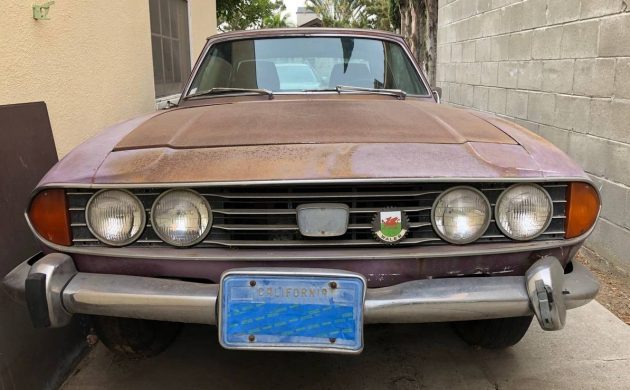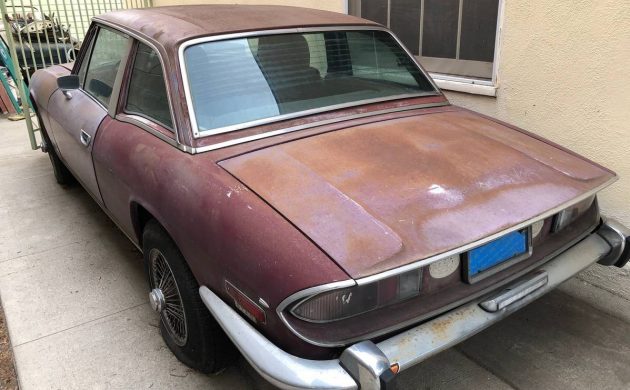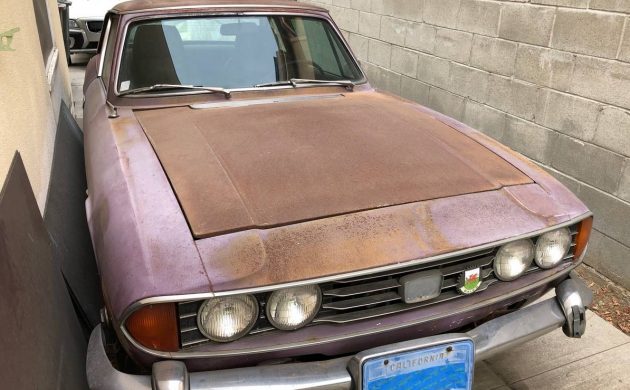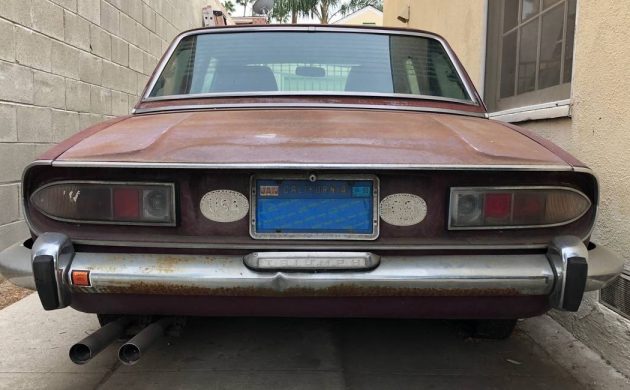I have covered quite a few British sports cars for Barn Finds. Topping the list are MGs of all ilks, Triumph TR4s, and a few Jaguars thrown in for good measure. Today, however, is a first for me in the form of a 1972 Triumph Stag. Rarely encountered anymore, this Stag is located in Glendale, California and is available, here on craigslist for $4,000.
The Triumph Stag was produced between 1970 and 1977 with a total output of about 26K copies and only 2,800 or so finding their way to the U.S. Where the Stag stands apart from other British sports cars is its V8 engine as opposed to the more typically found four-cylinder power plant used in other Triumphs and MGs. The body style was limited to one, a Sports Tourer, but either a soft or a removable hardtop was available. Back in 2007, Time Magazine author Dan Neil placed the Stag on his list of “The 50 Worst Cars of all Time“. More on that item to follow.
The seller of this Stag refers to it as a complete but not running car. It is sitting wedged into a narrow sort of alleyway so it’s difficult to get a comprehensive view but it does appear to be complete, straight, and not rotted out. The finish is pretty well burned off, probably from the southern California sun, and there is a light, real (not faux) patina to both the horizontal and vertical surfaces. It is (was?) an unusual color that is now hard to decipher, a sort of pinkish/purplish hue, it reminds me of a worn-out GM “Evening Orchid”. All of the trim appears to be present and the bumper chrome is fair to worn. But yes, overall, it appears to be a complete car. The seller states that the hardtop is, in fact, removable.
What makes this Triumph special, its 3.0-liter V8 engine, is also what garnered the enmity of many, including Mr. Neil from Time. The biggest problem was overheating coupled with cooling system corrosion brought on by not using the proper rust inhibitor antifreeze year-round. This electrolytic corrosion problem was somewhat the result of the iron block/aluminum head combination. Additional problems occurred with the overhead camshaft timing chains which quickly stretched, knocking the valve timing out of wack in what is an “interference” engine – valve and piston damage to follow. There is also an account of the cylinder head stud angle causing undue expansion force on the engine block, thereby causing the block to warp and the head gaskets to blow. Sounds lovely, right? Maybe this is one of the reasons I haven’t encountered one of these before…To add to the oddity, most Stags were equipped with a Borg-Warner, three-speed automatic transmission, and this example is no exception. The seller states that this 40K mile Stag is “not running at this time“. While the engine compartment looks complete, there is obviously a panoply of ills that could be affecting the engine.
The interior looks about as expected. It is dusty and the driver’s seat upholstery is split and worn. Additionally, the dash pad is cracked and the instrument panel’s wood veneer is cracking in places too. The carpet, consolette, door cards, and steering wheel, however, don’t look bad. This is one of those kinds of interiors where a good cleaning could work wonders.
The body tag states that this Stag was built in July of 1971 so that sounds more like a late ’71 model than a ’72 but I’ll have to assume that the seller knows what he’s selling. Knowing what we now know, or perhaps what many of you already knew about the Triumph Stag, this car seems like a risky proposition at $4,000. But I’ll have to agree with the seller, it is very complete. What do you think, is this car worth taking a chance or are we just looking for trouble?








SBC and four speed is the way to go with these unreliable cars. Even a V6 has been done and the car can be a joy, as long as the new owner re-ups their tetanus shots.
SBC? Why not just throw the car away?
Friend had two of these, one to drive and one for parts. Had them for about 12 years and never solved the engine problems. I eventually bought his rusty Bugeye, he dumped the Stags on some poor guy in the Carolinas, and went back to his Porsche 911.
Anyone else having trouble staying “logged in”?
Howard, I’ve been having the same problem for awhile and was wondering if anyone else was encountering it.
i remember working a few back when they were relatively new cars, could barely get the heads off and then the rust started when they were on the boat over. Truly were terrible cars and no amount of effort can overcome all the issues with them. Leave it in the alley.
One was sitting in a yard, in my neighborhood (northern California), for a couple years (disappeared recently). It supposedly ran and drove, with original engine and 4-speed (no OD). Upholstery was in pretty good shape but all the wood veneer was shot. As I recall, the owner wanted around $4,500, as I recall.
I thought that was steep but seems a bargain next to this offering. Was moderately oxidized medium dark blue metalic, hard top, minor body damage on passenger side
Color is Magenta and was also available on TR6.
Over the years the engine has had all its problems resolved. Putting something else in its place will ruin the value of the car, which incidentally has been on a steady rise lately. With the stock exhaust in place there is not a sweeter sounding V8 than this one. If this one is free of corrosion then it should be returned to the road. Nearly every spare including body panels are available.
I agree. I had a ’73 with a 4 speed manual. I rebuilt the engine – crank hard chromed, rotating parts balanced, viton O rings. Recored radiator with an electric fan. Never overheated, and was a blast to drive. Ditto on the exhaust note!
Bob,thanks for bringing that up,I am always surprised when the tendency is to dwell on the early days of a cars failures. The stag is a lovely car,especially with an upgraded original motor😁😍
Absolutely agree!
I agree. I had a ’73 with a 4 speed manual. I rebuilt the engine – crank hard chromed, rotating parts balanced, viton O rings. Recored radiator with an electric fan. Never overheated, and was a blast to drive. Ditto on the exhaust note!
A similar ’72 Stag in dark blue was my father-in-law’s pride and joy! He bought it new and loved to tinker so it was a perfect fit. He enjoyed it for about 10 yrs until he had to stop driving. It broke his heart to sell it. He sold it to a guy in Malibu. Heard later that it was totaled on PCH one night and the driver died….so sad😢
Bob,thanks for bringing that up,I am always surprised when the tendency is to dwell on the early days of a cars failures. The stag is a lovely car,especially with an upgraded original motor😁😍
Dreadful things. I sold them new in Oklahoma City. All automatics, and all came back on a hook, as the neutral isolator switch failed. Best story: Our dealer took the first pale yellow one off to his golf club to show off at lunch. He came back later, soaked and mad as a wet hen. There was a sudden cloudburst and he was unable to get the complicated manual top up (hi there, Allante owners!) Every Stag we got after that ONLY had a hard top. Most were brown as I recall. Hmmm, a V8 which was basically two TR7 engines back to back, with angled head studs? What could possibly go wrong? I have heard that they were sorted by 1977, but that was five years after the U.S. gave up.
Thank you Bob, and that’s what i would do if I bought it. They are lovely cars, with appropriate engine upgrades and whatever else it needs it a wonderful driver/tourer.
When l was growing up in south east England,l had a neighbor who owned not one, but two of them (red and white) and both were always in pieces!l now know why…..
Too bad BL got it so wrong!
When l was growing up in south east England,l had a neighbor who owned not one, but two of them (red and white) and both were always in pieces!l now know why…..
Too bad BL got it so wrong!
If a Stag needs a replacement engine [it’s easy to ruin the block if the angled head studs are corroded solidly to the heads]. the TR6 drive train is a fairly easy transplant, as the Stag was originally designed to use the TR6 engine & trans.
My brother bought one of these off a gravel lot on Nolensville Road, in Nashville. I’d love to leave it at that … but my then-girlfriend and I borrowed it for a trip to the Outer Banks. Like the little girl with the little curl, when it was good it was very, very good … and when it was bad it was horrid. Running the A/C in cool weather – good. In hot weather – BAD. Trying to get the power windows to go down on a hot day? ‘Fraid not. Trying to close them during a sudden cloudburst? Surely you jest! And on a slow-moving Saturday night parade through downtown Asheville, NC, I pulled under a very tall gas-station canopy when I heard boiling noises up front, and when I had just lifted the bonnet-lid the radiator cap blew off so hard it hit that canopy ceiling.
In between such fits, the car could be maddeningly hard to use on a daily basis, such as when we were headed home from work one evening and saw the sky was threatening rain, and the top was down. Putting it up required that we pull it forward to the windshield header, then one of us would stand on the hood and bounce his butt on the top’s forward part while the one inside the car would exert all possible strength to get … those … darned … pegs … INTO THEIR HOLES! That done, John started the car and we drove to the freeway on-ramp. There was a red light, and the car in front of us was a Spitfire, with its top down. As we waited, a few drops began falling. The guy in the Spitfire glanced up, then reached behind himself, grabbed his top by the header, pulled it forward and snapped into place, just as the light changed. The Rules under this text box prevent me from saying what John said, but he managed to sell the car for not very much the next day or so.
As I understand it, CA titles the vehicles in the year they are first sold new, without regard to model year, so this one could have sat around until 1972 to be sold. I have heard of cars that were three years old before being sold and were titled as such. The same thing apparently happens with cars used by dealers for senior staff that are not actually “sold” until the staff member turns it in for something else, so this original sale is of a technically “used” vehicle but considered new since it was never titled.
Brian M,
This was quite common with many states until the 1968 federal law that required the official model year to be used on state titles. In the mid 1970s I bought a 1957 Packard Clipper sedan from the original owner who bought the car as a brand new vehicle, but because he bought it in Pennsylvania, it was titled from new as a 1960, the year he bought it.
Of course the problem was, Packard ended production of vehicles at the end of 1958! Since I bought the car for parts, I didn’t worry about the date listing on the title, and I saved the title so I could show people I bought a 1960 Packard Clipper!
Had a friend down the street with one some 20-25 years ago. One day his differential fell out as I watched him drive by the house. Had to jack up the diff and roll the car back to his house. Hard to forget the sight of waving to a friend driving by and seeing the diff fall.
I remember reading all the articles that said this could have been a good car if BL internal politics had put the Buick-Rover V8 into it in place of the disastrously frangible dualing-Saabs contraption it was sold with. The only problem I have with that theory is every experience I have with Rover’s bought-in V8. I visited the shop I used to run, which makes its money off the disconnect between the perception of Subaru dependability and the reality of Subaru ownership. Nonetheless, any time someone leaves a pushrod V8 Land Rover product in the lot, within a few days there are three of them as desperate owners think the shop must hold the secret to keeping the coolant in the engine. They were piling up when I stopped by on Christmas Eve this year.
Allow me to set the record straight, please… In the mid-late 60’s Saab, somewhat desperate to develop its new model 99 cars, contracted with Triumph to supply them with (Triumph built) engines. Saab, immediately realized that the Triumph engines had some design flaws and reliability issues and by 1972, when that contract ran out, (and was NOT renewed) Saab was building it’s own engines based only loosely on that original Triumph design. The Saab built engines are widely regarded as being very robust and reliable.
By the way when Saab wanted more power, they began turbo charging their new engine design…. When Triumph wanted more power, they stuck two of their original (poorly designed engines) butt to butt, and got this monstrosity that we see here… Just don’t blame this mess on Saab, because they didn’t have anything to do with it!